Web-based instruction in higher education has grown exponentially, with more than a thousand universities offering courses over the Web in the United States alone.1Web-based instruction offers obvious advantages for distance and continuing education populations by making access to education at any time or place feasible. This kind of flexibility is similarly advantageous for informal or professional training. However, a major use of Web-based instruction is to enhance traditional, on-campus courses, where the benefit of Web enhancement as a supplemental resource is less obvious. Nonetheless, universities are investing significantly in course management software, expanded networks, and training and support capabilities to introduce Web enhancements to traditional courses. Faculty are embracing these tools as well and investing significant time and energy into adding Web-based supplements to their traditional courses.2
Much of the research on Web use in education has focused on specific applications and their perceived effects on outcomes. In a review of research on Web-based learning, Meyer acknowledged the difficulty in isolating the factors that influence online learning, such as the technologies or the students.3 Meyer also noted that assessing quality in traditional classroom settings is difficult for similar reasons. Much of the research comparing outcomes does not account for changes in instructional design and classroom teaching that may accompany the introduction of technology. Smith and Dillon called the interaction of technologies with instructional design the "media/method confound" and asserted that "it is not the technology that has an effect; it is the way it is used."4 Meyer, along with Newman and Scurry, suggested that online learning initiatives go beyond the technology itself to encourage institutions and faculty to "question assumptions and renew attention to student learning."5
Little has been reported on the specific impact of Web enhancements on classroom activities—the face-to-face component of traditional courses—and the nature of that impact. Recognizing the difficulty inherent in assessing the effect of technology on learning, Meyer recommended assessments based on factors already known to influence learning, such as increased interaction with faculty, peers, and content; opportunities to construct meaning from experiences; reflection on learning; and practice and feedback on applying new learning.
The Learning Technology Consortium Study
The Learning Technology Consortium, a forum for collaboration and support among institutions committed to technological innovation in higher education, is composed of nine major U.S. universities: Indiana University, Virginia Tech University, University of Delaware, University of Florida, University of Georgia, University of North Carolina, University of Notre Dame, University of Pittsburgh, and Wake Forest University. Faculty at each institution are involved in varying levels of Web enhancement of their traditional course offerings, from posting course syllabi online to facilitating online chats or discussions, to using the full features of the prevailing course management system. Faculty goals, applications of Web-based technologies, instructional strategies, outcomes, and experiences vary as much as the technologies themselves. Such consortia benefit from sharing experiences and lessons learned from Web-based initiatives. They also have the unique opportunity to review and evaluate the impact of such initiatives to improve the processes of instruction and learning with technology.
In the summer of 2001, the Learning Technology Consortium initiated a study to assess the impact of Web-based enhancements on teaching and learning activities taking place in traditional classrooms. This study's first objective—to identify changes in the classroom perceived by faculty to impact teaching and learning—was accomplished by gathering and analyzing detailed, qualitative information from a small sample of experienced faculty from different universities. Do faculty spend less time lecturing, for example, because they have put their lectures online? If so, what do they do instead—perhaps active learning activities? Do they spend more or less time on individual questions or consultation before, during, and after class because they are making greater use of Web-based communications? Does in-class student-student or student-instructor interaction increase? Does Web enhancement encourage higher expectations for the amount of content covered in the course or for improved performance?
The study's second objective was to explore the insights of technologically experienced faculty who could contribute to our understanding of what works in various settings, where we are today, and what we might expect in the future. Do faculty expect to expand their use of the Web in on-campus courses? Do they anticipate modest or radical changes in the amount of time committed to face-to-face instruction or in their classroom teaching methods, strategies, and activities? What do experienced faculty see as the greatest instructional potential of Web-enhanced university instruction? The insights and predictions of experienced faculty from varied disciplines and institutions can contribute to our ability to support all faculty in the development and delivery of effective Web-enhanced instruction.
Methodology
Seven Learning Technology Consortium institutions participated in this study: Virginia Tech, Delaware, Florida, Georgia, Notre Dame, Pittsburgh, and Wake Forest. Two principal investigators from the University of Pittsburgh coordinated the study. Each participating institution identified a representative to coordinate the study for that campus.
Study Participants
Each institution's representative was asked to identify up to 10 faculty experienced in teaching instructionally rich, Web-enhanced courses. "Experienced" was defined as a person having taught a Web-enhanced course for no less than four semesters. "Instructionally rich" was defined as including content (text, graphics, audio, and video), interaction (activities, quizzes, and so forth), and communication (e-mail, discussion, and group work).
The sample size was designed to allow for individual interviewing of each participant while providing a reasonable variety of perspectives. Faculty with experience using Blackboard, Oncourse, WebCT, or other course management tools were identified and contacted by the campus representatives. Participation entailed completing a preliminary online survey and taking part in an individually tailored interview of 60 to 90 minutes.
Seventy-three faculty were identified as potential candidates for the study. Fifty-six completed the online survey. Of those, 46 completed the interview and, therefore, made up the final study sample. The 10 faculty from the original sample who did not complete the interview failed to do so because of scheduling conflicts.
Not only was our sample selection designed to be specific in focus rather than representative of a broad population, the size was limited to accommodate exploratory, qualitative inquiry methods rather than to ensure statistical validity. The original sample of 56 faculty members did, however, represent every faculty rank (see Table 1), 4 academic areas (see Table 2), and 24 disciplines.
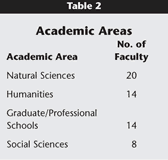
Click image for larger view. 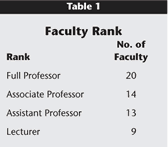
Click image for larger view.
A pattern emerged in the number of faculty grouped by years of teaching experience (see Table 3). It appeared that the longer faculty taught, the more likely they were to be selected as experienced Web users. Specifically, 28 faculty had more than 15 years of experience, while the smallest subset (7) had from 3 to 6 years of teaching experience. This is interesting because many of the younger faculty grew up during the electronic age. We would expect them to be early adopters. It could be, however, that experience with traditional instructional methods and strategies establishes the pedagogical foundation for creativity in teaching. Experience with traditional instruction might also expose specific challenges that faculty believe may be addressed by the Web.
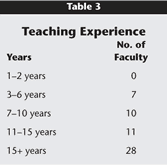
Click image for larger view.
Survey
The initial online survey obtained descriptive data about the faculty participants and their Web-enhanced courses. To assess experience level, the survey queried faculty's academic and professional backgrounds, years of teaching, years of Web use, and number of Web-enhanced courses taught. Items were included to determine the extent of training and support services received. Faculty were also asked to indicate the degree to which they used various Web capabilities or planned to do so (see Table 4). Finally, the survey asked faculty to estimate perceived changes, if any, for one course in the amount of time spent on a variety of in-classroom activities as a result of Web enhancement initiatives (see Table 5). For example, faculty reported whether "lecturing," "group work," or "student-to-student interaction" had increased, decreased, or stayed the same when Web enhancements were introduced.
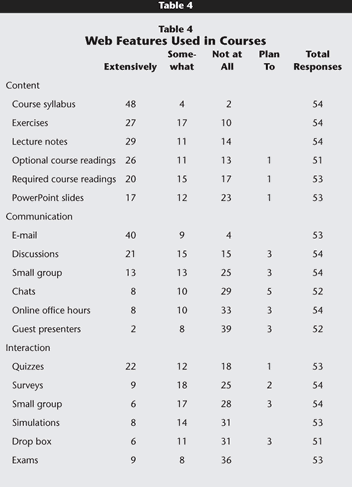
Click image for larger view.
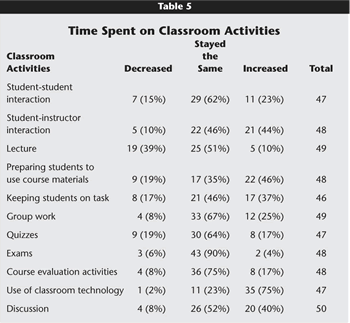
Click image for larger view.
Interview
The semi-structured interview was designed to gather expansive, qualitative data about classroom changes perceived by faculty to result from adding Web enhancements. Specific interview items were tailored to individual faculty survey responses in order to elicit more detailed information. For example, faculty who reported using the Web routinely to post lecture notes and commentaries previously delivered in class (see Table 4) were asked how this affected their in-class lecturing and whether any new activities were introduced.
Faculty who reported posting only handouts and supplemental information were asked if they lectured as usual and whether access to these materials influenced the classroom. Faculty who used communication capabilities were asked whether and how that use influenced the amount and kinds of communication in the classroom.
Interviewers probed how class time saved by Web functions was then used. For example, was additional class time available for instructional activities, such as discussions or demonstrations?
Results
Although 56 faculty completed the survey, each did not respond to all items. The figures in the total responses column represent the total number of faculty responding to that particular item (see Table 4).
Faculty were asked to report any changes in the way classroom time was spent on common instructional activities after introducing Web enhancement to their courses (for example, did these activities increase, decrease, or stay the same?). The percentages given are based on the total number of faculty responding to each item rather than to the total sample of 56 (see Table 5).
On the survey, faculty reported less change in the classroom than they reported subsequently during the interviews. In many cases, faculty appeared not to have been conscious of the changes until specifically asked in the survey about the impact of the Web. Interestingly, many faculty would later explicitly revise their survey responses during the interview, reflecting recognition of change.
More than half the responding faculty reported that the amount of student-student interaction in the classroom remained the same after their courses were Web enhanced. Those reporting change most often reported increased interaction. Similarly, almost half reported student-instructor interaction remained the same, and slightly less than half reported that it increased. Although more than one third of the faculty reported lecturing less, more than half reported no change in their in-class lecturing time.
Almost half the faculty reported spending more time in class to prepare their students to work with the course materials. This can be expected to change as students become acclimated to course management systems.6 Little change was reported in time committed to group work, quizzes, exams, and course evaluation activities. In contrast, almost half reported increased discussion, although slightly more reported no change. Over half the faculty reported an increase in use of classroom technology.
Faculty Goals
Since faculty's goals for adding Web enhancements were expected to guide early Web applications and subsequent experiences, interviews began by asking faculty about their initial goals and what changes in the classroom they expected and experienced. A content analysis of responses yielded six factors (goals) that fell into two categories. Web enhancements were initiated primarily for either (1) pragmatic purposes or (2) instructional purposes. The goals were not mutually exclusive. Faculty often had more than one goal in mind.
Pragmatic Goals. Pragmatic course management goals included efficient material distribution, easier (any time, anywhere) student access to materials, enhanced communication, and personal or curricular interest in the technology (N = 46):
- Convenient material distribution and easy student access—31 faculty (67 percent)
- Communication—9 faculty (20 percent)
- Technology interest or direct relevance to topic—14 faculty (30 percent)
Distribution of materials and immediate student access was seen as an opportunity to accomplish efficiently otherwise time-consuming tasks (such as printing and distributing syllabi, readings, assignments, expanded supplemental resources, and handouts). Well over half the 46 faculty reported this as one of their primary goals in introducing the Web. Similar findings have been found by others.7
In addition, faculty recognized the advantage of being able to revise or update course outlines, schedules, or materials quickly and efficiently and to make those revisions immediately accessible to students. Many of the faculty who had been seeking course material distribution and access benefits reported quickly recognizing the unanticipated advantages of expansive, rich Web resources in augmenting course content.
Twenty percent of the faculty specifically sought the practicality and convenience of using the Web for communicating easily with students, delivering assignments, posting grades, responding to questions, and making announcements. This eliminated or reduced the need to handle these clerical tasks during class time. In addition, faculty reported that with the Web, students were able to contact one another outside of class to study, collaborate on projects, or work on group assignments.
For almost a third of the participating faculty, personal interest in the technology or the direct relevance of the technology to the course content influenced Web use. For example, information or computer science courses naturally lend themselves to Web use. Others, in disciplines such as social work, communication, or education, serve students who may be expected to demonstrate Web-related competencies in their professional roles. As one professor noted, it is important to use technology because it is the future for many of the students.
Pedagogical Goals. A smaller proportion of the faculty initially added Web enhancements to address pedagogical goals (N = 46):
- Course organization—8 faculty (17 percent)
- Expanded resources—7 faculty (15 percent)
- Individualized instruction—3 faculty (6 percent)
Eight of 46 faculty anticipated improving the organization of their course materials and course management tasks by putting the content into a Web template that was expected to improve the quality of the instruction. Seven faculty specifically cited the benefits of multimedia resources or simulations to illustrate difficult concepts in their respective disciplines. Three faculty reported being motivated to use the Web to individualize their instruction to accommodate the unique needs or learning styles of some students. For example, an otherwise competent student with a weak background in a prerequisite skill for a given course could be directed to relevant supplemental resources on the Web. Students could revisit content as often as needed or meet with their instructors and/or their classmates in a chat room on a weekend or evening to ask questions and resolve problems that would otherwise impede their progress until the next class.
Although pragmatic goals motivated a majority of faculty, many reported changing goals over time—and with experience—toward increased awareness of instructional benefits. This phenomenon has been reported by others as well.8 Anecdotal data suggested that this might be the case and contributed to the emphasis on experience in faculty selection criteria for this study. It was expected that pedagogical benefits might emerge as pragmatic use of the Web became more routine. Interview data confirmed this expectation, as many more faculty reported deriving pedagogical advantages from adding Web enhancements than had originally anticipated such changes.
Faculty who had the opportunity to work with instructional designers to coordinate the addition of Web enhancements to their courses often reported that they increased their familiarity with learning theory and enhanced their teaching and course development skills in general. Consequently, the collaborative, instructional development process advanced sensitivity to instructional benefits and/or potential of the Web, as suggested by Meyer and by Smith and Dillon.9–10
Changes
Faculty comments on the changes in the classroom included both anticipated and unanticipated changes. The interview instrument was designed to elicit descriptions of changes and the perceived impact of those changes on instruction and learning. Given the goals faculty discussed, it was expected that lecturing, for example, would decrease and that the instructional methods and activities might change as an effect of less lecturing. Analysis of the data revealed changes in three broad categories:
- the degree of interaction among participants in the course,
- the nature and delivery of course content, and
- the teaching and learning process itself.
Changes in Interactions. Faculty were asked if the amount or type of interaction in the classroom changed as a consequence of adding Web enhancement to the course. A considerable proportion of faculty also commented on changes in the level of interaction outside the classroom, noting that this influenced subsequent classroom interactions and the classroom environment itself. Therefore, responses for both types of communication are reported here (see Table 6). Every faculty member did not respond to each item. The percentage of the total sample of 46 faculty reporting a particular change is provided in parentheses, since we can assume that faculty who did not respond to an item did not perceive an increase of any kind.
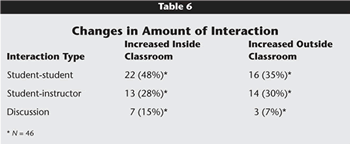
Click image for larger view.
Nearly half of the respondents reported increased interactions among students in the classroom, and slightly more than a third reported increased student-student interactions outside the classroom. Faculty also reported an increase in student-instructor communication both in and out of the classroom. Of particular interest is the faculty perception that students were generally more comfortable in the classroom as a result of early and continual e-mail communications with other students and with the instructor inside and/or outside of the classroom.
This phenomenon is supported by Reeves and Nass's reference to media's satisfaction of our human need for relationships even if by way of computer.11 Reeves and Nass also suggested that opportunities for increased interaction through the Web promote a sense of community in the context of distance education.
It appears that opportunities for interaction have the same benefit in more traditional settings. Many faculty reported that this increased comfort level subsequently contributed to elevated levels of engagement and communication in the classroom.
It also was interesting that, as a result of increased communications and interactions in and outside of the classroom, a few faculty spoke of improvements in their own comfort levels in class and of feeling more prepared and more familiar with their students' academic progress. Seven faculty reported increases in classroom discussions, and three reported increased discussions outside of class in discussion forums or e-mail (see Table 6). These smaller numbers support anecdotal data suggesting that faculty find discussion a challenging instructional strategy to employ effectively in the classroom, and even more so online.
Changes in Content—Nature and Delivery. The addition of Web components to a course does not necessarily change instructional content, but it does offer alternative means of delivery and, as mentioned, expands the amount of information available to students. The following changes were reported (N = 46):
- Convenient course material delivery—27 (59 percent)
- Expanded resources—24 (52 percent)
- Decreased lecturing—23 (50 percent)
- Increased lecturing—2 (4 percent)
- Increased media use in the classroom—12 (26 percent)
- Access to materials minimizes note taking —11 (24 percent)
More than half of the 46 faculty interviewed noted the efficiency and convenience of making course materials available on the Web. Some faculty added that because information could be expanded, updated, or corrected quickly and distributed immediately, course information was more current and correct than it would have been without the Web.
While only 15 percent of the faculty originally cited expanded resources as one of their goals in adding Web enhancement, when interviewed, half commented on the benefits of expanded resources. These faculty described available resources as richer, timelier, and more authentic than could be delivered to students before the Web. In contrast, a few faculty expressed concerns about the proliferation of materials available online and the risk of information overload and distraction for students.
With so many course materials and supplemental resources accessible from the Web, it seems natural that there would be less lecturing in the classroom. When interviewed, half of the faculty in fact did report a decrease in lecturing—more than had reported a decrease on the survey. Interestingly, two faculty members reported an increase in lecturing in response to the expanse of information. They perceived a need to provide students with instruction on critically evaluating the credibility, relevance, and appropriate referencing of Web resources. For a third of the faculty, who reported no change in their lecturing, changes often were noted in the content of their lectures—for example, more extensive, detailed, or challenging. For about a quarter of the faculty, the time freed from lecturing was used for different kinds of delivery, including videos or multimedia demonstrations.
Changes in Teaching and Learning. How then, have the reported increases in interaction, expansion of instructional resources, and increased use of technology in the classroom contributed to changes in the quality of teaching and learning? Do Web enhancements support the goals cited in "Seven Principles of Good Practice in Undergraduate Education"?12
Just as some faculty noted the increased comfort level of students in the classroom, a number identified an enhanced sense of continuity in the learning process between classes (see Table 7). The potential for continual out-of-class e-mail communications, along with access to course materials any time, anywhere, was credited with promoting this improved sense of course continuity.
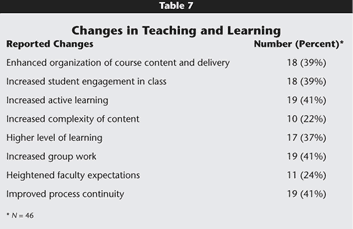
Click image for larger view.
The enhanced comfort level and sense of continuity were reported to positively influence student engagement and active learning in the classroom—both critical components of effective learning. Almost 40 percent of the faculty reported an increase in student engagement and/or active participation in the classroom. Three faculty recognized a secondary advantage to downloadable or printable course materials (including outlines and complex graphics) in minimizing students' need to take comprehensive notes and to duplicate complex diagrams during class. This further enhanced students' ability to remain engaged in the ongoing classroom activities.
In addition to changes in the amount, nature, and delivery of course content, faculty reported changes in the organization of their instructional materials. Whereas only 17 percent of the faculty reported in the survey that course organization had motivated them to add Web enhancements, in the interviews 39 percent reported a noticeable improvement in organization as a result of preparing their instructional materials for the Web. One professor commented that the organization of the Web materials helped him, as well as his students, remain focused on the goals of the course. Another reported that organizing Web enhancements forced her to think more about instruction and instructional strategies.
For some faculty, using a course management system afforded them the opportunity to work with instructional designers for the first time and to refine skills in developing goals, objectives, tasks, and assessments to be interrelated. Many faculty reported that the Web-development process automatically encouraged reconsideration of course goals, teaching strategies, and outcome expectations and consequently resulted in enhanced early planning, instruction, and student learning.
An unanticipated consequence of continual and comprehensive student access to course materials and resources was an elevation of faculty's expectations for students. Almost a quarter of the faculty reported heightened expectations for their students. They began to believe that students could take responsibility independently for their learning of basic course information provided on the Web. Over a third of the faculty introduced higher-level, more challenging instruction in their classes rather than reiterate information readily available elsewhere. Chickering and Ehrmann suggested that "new technologies can communicate high expectations explicitly and efficiently."13
Online quizzing and feedback also increased opportunities for independent practice and mastery of basic skills and enabled students to better prepare for the heightened challenges in the classroom. This can be especially important for large courses, where administrative demands constrain the regular use of quizzing and feedback, one of Chickering and Gamson's seven principles.14 Although many faculty used online quizzes as a method of providing more practice and feedback for students, they continued to feel uncomfortable changing traditional procedures for administering academic exams in the classroom due to concerns with academic security.
Finally, because most of the faculty reported augmenting their classroom presentations with PowerPoint in conjunction with the Web, they also reported being able to create increasingly complex, refined examples, diagrams, graphics, and models outside of class to illustrate effectively the increasingly complex concepts discussed in class. Using PowerPoint in class also encouraged eye contact between faculty and students, increasing student engagement. A chemistry faculty member reported that before introducing PowerPoint in the classroom, he spent 99 percent of class time facing the blackboard, while today he spends 99 percent of his time facing his students or walking around the room monitoring their progress. For a few faculty, multimedia capabilities in the classroom made simulations and three-dimensional models feasible for the first time.
Support Services
Faculty responses to questions regarding availability of support services were overwhelmingly positive. About twice as many spoke about technical services and support than mentioned instructional development services and support. This reflects the previously mentioned common tendency among faculty to focus initially on the technologies rather than the underlying pedagogical goals.
Although satisfied, many faculty mentioned the potential benefits of expansion of electronic infrastructure on campus, increased connectivity across campus, increased numbers of media-equipped classrooms, and provision of (or increase of) department-centered technical support services. Some faculty expressed the need for more technical support and technical training. This seems to reflect the ongoing need for technical expertise in higher education rather than any deficiency in the services currently available.
Many faculty expressed an interest in sharing with other faculty their experiences using the Web and showcasing best practices among faculty and institutions. Given the evolution from pragmatic to pedagogical applications identified here in response to continued Web experience, such collaboration could enhance the developmental process to everyone's advantage. For development of new Web-enhanced courses or enhancement of existing courses, most faculty cited the need for incentives or release time.
Faculty's Future Plans
Faculty were asked to report their plans for continued use of the Web (see Table 8). More than a third of the faculty expected to continue using the Web, while over half expected to expand their use. Faculty expecting to expand Web use envisioned increasing the use of media, raising the level of instruction, integrating the Web more comprehensively into courses, developing disaggregated modules that could be used across courses and disciplines, and developing self-paced online courses.
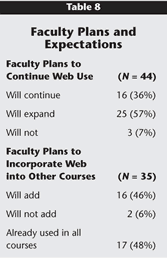
Click image for larger view.
The impact faculty anticipated from expansion of their use of the Web included
- more efficient face-to-face interactions,
- more active learning,
- decreased in-seat contact hours,
- more readily available practice and feedback opportunities for students, and
- more student-centered instruction.
Only three faculty did not expect to continue using the Web. In one case, the faculty member anticipated a fragmentation of students' reading and writing as a result of extensive Web resource use. In another case, the faculty member was apprehensive about the Web as a primary information source in lieu of peer-reviewed literature and expressed concerns about the credibility and accountability of such Web resources. The third suggested that the Web was appropriate for distance education but not traditional education—rapport between faculty and students can only be established effectively, and productive feedback effectively given, face-to-face.
When asked if they had plans to incorporate the Web into other courses, more than a third of faculty reported that they would do so as time permitted (see Table 8). Another third were already using the Web in all their courses. Two faculty did not plan to add the Web to other courses, and 11 faculty did not respond to this item.
It appears that faculty use of the Web generally will increase over time and with increased experience. A relatively small number, however, remain skeptical of the value of Web enhancements and uncommitted to use of the Web in their teaching. Research suggests that, for some, the time involved in updating and maintaining a Web site is deemed excessive; for others, the course management systems are too restrictive or online instruction is not considered conducive to the discipline.15
Web Potential
In response to inquiries about their perception of the Web's potential in higher education, faculty reported many more positive expectations than negative. Many simply said the potential was limitless. Others discussed increased instructor effectiveness, increased sharing and collaboration among faculty, replacement of paper materials with electronic resources, increased discussion and interaction in the classroom, support for new instructional approaches, expansion of research options, and creation of new dimensions to learning through the media.
Again, a few faculty expressed apprehension about the Web's becoming a primary source of information for students and emphasized the need to teach students to be discriminating in their selection of resources. One faculty member was concerned that distance learning through the Web would ultimately replace face-to-face instruction altogether and that this would be inherently bad for education. As previously noted, another expressed concern that students' writing styles could become more and more fragmented because of the Web.
Discussion
This study was designed to assess the kinds of changes that occur in face-to-face classroom instruction when courses become Web enhanced, and faculty perceptions of future trends in Web enhancement of courses. The changes identified here—such as adjustments in the amount, focus, and difficulty level of lecturing; increased interaction; heightened student engagement; increased comfort levels; and heightened faculty expectations—seemed to evolve over time and with experience. The longer faculty work with the Web, the more likely they are to pursue and derive pedagogical benefits from the technologies, but this process may take longer and require more collaboration than anticipated. In most cases, faculty did not introduce entirely new instructional strategies to the classroom. For example, discussion was seldom introduced as a new instructional strategy if it had not already been in use before the addition of Web enhancement.
The evolutionary nature of this process suggests that various types of technical training and support, as well as instructional development support opportunities, should be available to faculty throughout the process. As Meyers suggested, the process of critically reviewing a course to add Web enhancements affords the opportunity to critically reassess course goals, objectives, and design, encouraging fundamental instructional enhancements.16
Most faculty began to use the Web for pragmatic rather than pedagogical reasons, such as efficient distribution of course materials and provision of easy, round-the-clock access to the broader content resources of the Web for students. Although pragmatic goals are not focused on pedagogy, faculty recognize that they can influence learning. The Web itself, even simple uses of the Web (for example, posting course materials for ready access or posting announcements), can be motivating for students, can promote a sense of connectedness, and can help students accommodate difficult schedules.17–19 All of these effects will foster an environment conducive to learning.
This study found that, over time, more and more faculty began to recognize the instructional benefits of Web enhancements beyond the pragmatic. The availability of Web resources, improved organization of courses and materials, and the ability to individualize supplemental instructional resources for under-prepared students were among the advantages recognized most quickly.
Half the faculty reported a decrease in the amount of lecturing done in the class, while many others reported changes in the content itself, the manner of content presentation, or the complexity of content. Faculty reported increased interaction inside and outside of the classroom, especially among students, but also between students and faculty. Increased interaction outside the classroom was credited with positively influencing the atmosphere and interaction inside the class. Faculty reported that they, and their students, experienced an enhanced level of comfort, sense of continuity, and engagement in the classroom due to the early and continual interactions. It is important to remember that this information is based on the faculty members' perceptions rather than a formal measure of interaction.
The increases reported by faculty in communication and interaction among students and between students and faculty, inside and outside of the classroom, are certainly compatible with recommendations offered in "Seven Principles for Good Practice," as is the increase in student engagement and active learning in the classroom.20 These principles encourage contact; productive, responsive communications; reciprocity and cooperation among students and between students and faculty; sufficient time on task; prompt feedback; active learning activities; communication of high expectations; and respect for diverse interests and learning styles.
Although this study was not designed specifically to measure the seven principles of good practice, the benefit of some of the changes we did identify (such as increased communication among students and between students and faculty in and out of class, time on task, active learning, and heightened expectations) is well supported by Chickering and Gamson. Faculty who most actively discussed the pedagogical potential of the Web and course management systems were those who had worked with instructional designers and were familiar with the language of pedagogy.
A significant number of faculty in this study felt that adding the Web improved preparation for class, for themselves as well as for their students, and that this increased preparation contributed to greater student engagement and active learning in the classroom. Faculty often felt more familiar with their students' academic progress during the term and reported a growing expectation that students could take more responsibility for learning the fundamentals independently from the readily available resources provided on the Web. Significantly, over a third of the faculty reported delivering a higher level of instruction in the classroom and expecting students to meet higher expectations.
An increased ability to use media and preplanned, well-designed, mediated materials in the classroom enabled faculty to provide complex, graphical illustrations, models, or simulations to enhance and support the higher level of classroom learning. The availability of these and other resources for students to download before class was thought to enable them to remain more engaged with the class rather than with note taking.
It is important to note, however, that not all the changes described here happened in every classroom. Faculty at one end of a continuum reported that no changes would be found in their classrooms as result of Web enhancement. The enhancements were marginal to the class. At the other end, faculty described specific pedagogical improvements, higher expectations, and higher levels of learning. For the purpose of qualitative research, these are equally important and useful findings, suggesting areas that might be enhanced with appropriate faculty development services, as well as areas in need of further research.
The time and effort required to redesign instruction for effective use of Web capabilities slow the process of change. However, faculty overwhelmingly acknowledged the benefits. Researchers' expectations about rate of change in courses might have been unrealistic.
More than half the faculty expect to expand their use of the Web. They expect to integrate the Web more comprehensively into their courses, create disaggregated modules to be used across courses, and develop self-paced courses using the Web. Faculty also expect that use of the Web may result in more efficient face-to-face interactions, more active learning, decreased in-seat contact hours, more readily available practice and feedback opportunities for students, and more student-centered instruction.
Many faculty expressed interest in opportunities to share ideas, successes, and failures. Increasingly, this interest is being addressed with the emergence of numerous collaborative opportunities such as The Learning Technology Consortium, technology discussion groups, technology listservs, the Teaching Learning Technology Group, the MERLOT Web site, and the Flashlight Project. Faculty collaboration on best practices should be encouraged within and among institutions.
Faculty also recognize the inherent and perpetual need to extend electronic infrastructures and increase connectivity, media-enhanced classrooms, and technical support to accommodate the growing demand for Web-enhancement capabilities. Reports from faculty suggest that training in the capabilities and use of new technologies and ongoing collaboration, ideally with an instructional designer, on review and revision of course materials will contribute to effective initiatives.
In this study, the variability in experiences reported is more evident among individual participants than among institutions, academic areas, or disciplines. However, the relationship between disciplines and Web use should be explored more extensively in future studies. Findings reported here also suggest the benefits to be derived from a follow-up, longitudinal study on the effects of continued experience with the Web. Similarly, it would be interesting to explore student perceptions of Web enhancement efforts as compared to faculty perceptions.
